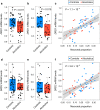Dynorphin and κ-Opioid Receptor Dysregulation in the Dopaminergic Reward System of Human Alcoholics
- PMID: 29383684
- PMCID: PMC6061161
- DOI: 10.1007/s12035-017-0844-4
Dynorphin and κ-Opioid Receptor Dysregulation in the Dopaminergic Reward System of Human Alcoholics
Abstract
Molecular changes induced by excessive alcohol consumption may underlie formation of dysphoric state during acute and protracted alcohol withdrawal which leads to craving and relapse. A main molecular addiction hypothesis is that the upregulation of the dynorphin (DYN)/κ-opioid receptor (KOR) system in the nucleus accumbens (NAc) of alcohol-dependent individuals causes the imbalance in activity of D1- and D2 dopamine receptor (DR) expressing neural circuits that results in dysphoria. We here analyzed post-mortem NAc samples of human alcoholics to assess changes in prodynorphin (PDYN) and KOR (OPRK1) gene expression and co-expression (transcriptionally coordinated) patterns. To address alterations in D1- and D2-receptor circuits, we studied the regulatory interactions between these pathways and the DYN/KOR system. No significant differences in PDYN and OPRK1 gene expression levels between alcoholics and controls were evident. However, PDYN and OPRK1 showed transcriptionally coordinated pattern that was significantly different between alcoholics and controls. A downregulation of DRD1 but not DRD2 expression was seen in alcoholics. Expression of DRD1 and DRD2 strongly correlated with that of PDYN and OPRK1 suggesting high levels of transcriptional coordination between these gene clusters. The differences in expression and co-expression patterns were not due to the decline in neuronal proportion in alcoholic brain and thereby represent transcriptional phenomena. Dysregulation of DYN/KOR system and dopamine signaling through both alterations in co-expression patterns of opioid genes and decreased DRD1 gene expression may contribute to imbalance in the activity of D1- and D2-containing pathways which may lead to the negative affective state in human alcoholics.
Keywords: Alcohol addiction; Co-expression of gene clusters; D1-pathway; D2-pathway; Dynorphin; Dysphoria; Nucleus accumbens; Post-mortem human brain tissue; Reward system; κ-opioid receptor.
Conflict of interest statement
Competing Interest
The authors declare that they have no conflict of interest.
Consent for Publication
Not applicable.
Ethical Approval and Consent to Participate
Informed written consent for autopsy was obtained from the next-of-kin, and collection was approved by the Human Research Ethics Committees of the Sydney Local Health District (X15-0199) and the University of Sydney. The study was approved by the Swedish Central Ethical Review Board.
Figures





Similar articles
-
Downregulation of the neuronal opioid gene expression concomitantly with neuronal decline in dorsolateral prefrontal cortex of human alcoholics.Transl Psychiatry. 2018 Jun 20;8(1):122. doi: 10.1038/s41398-017-0075-5. Transl Psychiatry. 2018. PMID: 29925858 Free PMC article.
-
Maladaptive behavioral regulation in alcohol dependence: Role of kappa-opioid receptors in the bed nucleus of the stria terminalis.Neuropharmacology. 2018 Sep 15;140:162-173. doi: 10.1016/j.neuropharm.2018.07.034. Epub 2018 Jul 31. Neuropharmacology. 2018. PMID: 30075159 Free PMC article.
-
Modulation of 5-HT release by dynorphin mediates social deficits during opioid withdrawal.Neuron. 2022 Dec 21;110(24):4125-4143.e6. doi: 10.1016/j.neuron.2022.09.024. Epub 2022 Oct 5. Neuron. 2022. PMID: 36202097 Free PMC article.
-
Dynorphin/Kappa Opioid Receptor Signaling in Preclinical Models of Alcohol, Drug, and Food Addiction.Int Rev Neurobiol. 2017;136:53-88. doi: 10.1016/bs.irn.2017.08.001. Epub 2017 Sep 12. Int Rev Neurobiol. 2017. PMID: 29056156 Review.
-
Role of the Dynorphin/Kappa Opioid Receptor System in the Motivational Effects of Ethanol.Alcohol Clin Exp Res. 2017 Aug;41(8):1402-1418. doi: 10.1111/acer.13406. Epub 2017 Jun 5. Alcohol Clin Exp Res. 2017. PMID: 28425121 Free PMC article. Review.
Cited by
-
Targeting the intracellular signaling "STOP" and "GO" pathways for the treatment of alcohol use disorders.Psychopharmacology (Berl). 2018 Jun;235(6):1727-1743. doi: 10.1007/s00213-018-4882-z. Epub 2018 Apr 14. Psychopharmacology (Berl). 2018. PMID: 29654346 Free PMC article. Review.
-
Targeting the Glucocorticoid Receptors During Alcohol Withdrawal to Reduce Protracted Neurocognitive Disorders.Front Psychiatry. 2019 Sep 18;10:580. doi: 10.3389/fpsyt.2019.00580. eCollection 2019. Front Psychiatry. 2019. PMID: 31620025 Free PMC article. Review.
-
Dorsal Striatum Transcriptome Profile Profound Shift in Repeated Aggression Mouse Model Converged to Networks of 12 Transcription Factors after Fighting Deprivation.Genes (Basel). 2021 Dec 22;13(1):21. doi: 10.3390/genes13010021. Genes (Basel). 2021. PMID: 35052361 Free PMC article.
-
Systemic kappa opioid receptor antagonism accelerates reinforcement learning via augmentation of novelty processing in male mice.Neuropsychopharmacology. 2023 May;48(6):857-868. doi: 10.1038/s41386-023-01547-x. Epub 2023 Feb 17. Neuropsychopharmacology. 2023. PMID: 36804487 Free PMC article.
-
Voluntary Exercise Ameliorates Chronic Ethanol Withdrawal-Induced Adaptations of Opioid Receptor Expression in the Nucleus Accumbens, Dopamine Release, and Ethanol Consumption.Biomedicines. 2024 Jul 17;12(7):1593. doi: 10.3390/biomedicines12071593. Biomedicines. 2024. PMID: 39062166 Free PMC article.
References
-
- Sarkisyan D, Bazov I, Watanabe H, Kononenko O, Syvanen AC, Schumann G, Yakovleva T, Bakalkin G (2017) Damaged reward areas in human alcoholics: neuronal proportion decline and astrocyte activation. Acta Neuropathol. 10.1007/s00401-017-1675-0 - PubMed
MeSH terms
Substances
Grants and funding
LinkOut - more resources
Full Text Sources
Other Literature Sources

